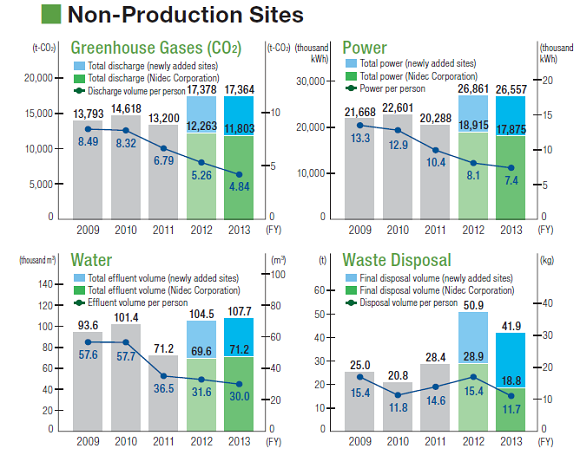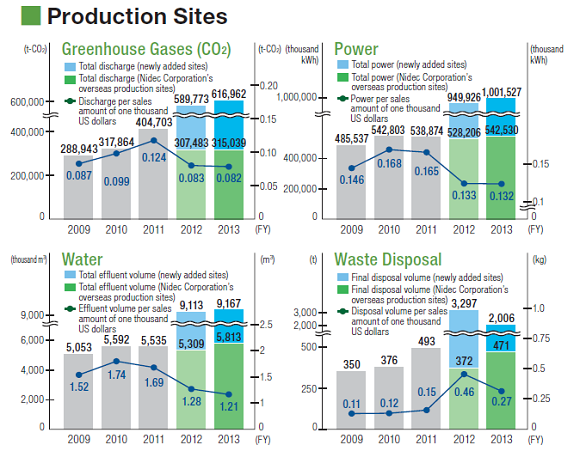Environmental Performance
Environmental Performance 2013
Mid-Term Environmental Conservation Plan and Results
In the wake of the ratification of the Kyoto Protocol, Nidec has been executing three-year mid-term plans addressing five major environmental issues since FY2004, and the fourth such mid-term plan (FY2013–FY2015) was launched in FY2013. The latest mid-term plan covers far more sites and offices than before, including Japan-based subsidiaries that joined the Nidec Group via M&A, in addition to group companies that had been covered by previous plans (i.e. Nidec Corporation and its overseas production sites). Accordingly, the categories of information disclosure and the basic unit were updated (see charts at bottom of P20), due to the increased diversity of Nidec products addressed. In addition, based on the recent trends in environmental conservation activities, two new categories, “power usage reduction” and “water usage reduction,” were added to the five existing categories of activity covered by past mid-term plans, bringing the total number of categories to seven.


Overall Picture of Environmental Burden
A major part of greenhouse gas emissions generated by our business activities is derived from electricity and fuel consumption; therefore, the key element in reducing our greenhouse gas emissions is to improve energy use efficiency at production sites.

Major Environmental Burdens



〈 Greenhouse Gas Emissions 〉 Non-production sites continuously executed energy-saving measures, and successfully reduced their greenhouse gas emissions compared with the previous fiscal year in terms of both basic unit and total discharge. Total discharge at production sites increased due to an increase in production volume and sales, but their greenhouse gas emissions decreased slightly in terms of basic unit.
〈 Power Usage Reduction 〉 Non-production sites successfully reduced their power consumption in terms of both basic unit and total power consumption due to energy-saving efforts such as switching to energy-saving (LED) lights and better temperature control. Total power consumption at production sites increased due to an increase in production volume and sales, but the increase in power consumption was suppressed by energy efficiency improvement through the introduction of energy-saving equipment, as well as the consolidation of production sites. All these actions led to a slight decrease of power consumption in terms of basic unit.
〈 Water Usage Reduction 〉 Total effluent volume at non-production sites increased compared with the previous fiscal year due to an increase in the number of employees after a technical center was newly opened, but decreased slightly in terms of basic unit. Total effluent volume at non-production sites increased due to an increase in production volume and sales, while decreasing in terms of basic unit compared with the previous fiscal year due to improvement in effluent facilities and introduction of water recycling equipment.
〈 Final Waste Disposal Volume 〉 Final disposal volume at non-production sites decreased in terms of both basic unit and final volume compared with the previous fiscal year due to an improved recycle ratio made possible by comprehensive disposal sorting. Final disposal volume at production sites also decreased in terms of both basic unit and final volume compared with the previous fiscal year due to an improved recycle ratio made possible by comprehensive disposal sorting, as well as other successful efforts such as reduction in the quantity of transportation packaging materials used.

